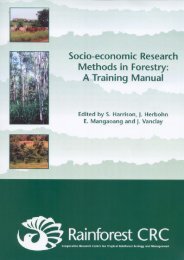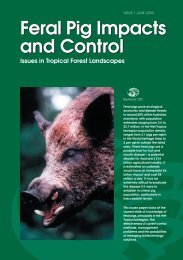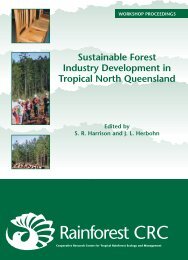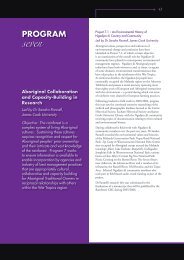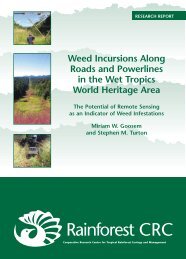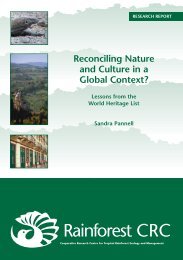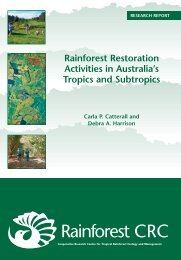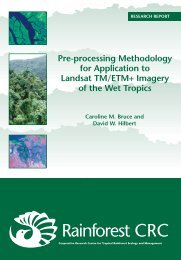Reconciling Nature and Culture in a Global Context? - Rainforest ...
Reconciling Nature and Culture in a Global Context? - Rainforest ...
Reconciling Nature and Culture in a Global Context? - Rainforest ...
Create successful ePaper yourself
Turn your PDF publications into a flip-book with our unique Google optimized e-Paper software.
S<strong>and</strong>ra Pannell<strong>and</strong> visitor <strong>in</strong>formation centres, which form the locus for tourist visitations to World Heritageproperties, unwitt<strong>in</strong>gly reproduce elements of these by-gone practices. For example, at theKīlauea Visitor Centre <strong>and</strong> Jaggar Museum with<strong>in</strong> the World Heritage listed HawaiiVolcanoes National Park, native Hawaiian people <strong>and</strong> their beliefs are presented <strong>in</strong> atimeless mythological space, while their material culture, conf<strong>in</strong>ed to stone-axe quarries <strong>and</strong>petroglyphs, is located <strong>in</strong> a distant neolithic past. As depicted <strong>in</strong> the official Park brochure,‘Visit<strong>in</strong>g Hawai’i Volcanoes’, native Hawaiian history (<strong>and</strong> by <strong>in</strong>ference, native Hawaiiansthemselves) “fade[s] away” with the arrival of Europeans <strong>in</strong> 1778. The use of nativeHawaiian terms to describe some of the geological products of volcanism exemplifies thereification <strong>and</strong> temporal distanc<strong>in</strong>g of culture <strong>in</strong> this World Heritage property.As this example <strong>in</strong>dicates, <strong>in</strong> attempt<strong>in</strong>g to present people <strong>and</strong> their values as ‘liv<strong>in</strong>g’exemplars, readily <strong>in</strong>telligible to the view<strong>in</strong>g public, cultural heritage is often displayed as astaged performance or as an <strong>in</strong>animate ethnographic spectacle. Yet, as BarbaraKirshenblatt-Gimblett observes, “[w]hile it looks old, heritage is actually someth<strong>in</strong>g new”(1998: 7). Despite the language of the World Heritage Convention, <strong>and</strong> its discursive focusupon protection, preservation, restoration, <strong>and</strong> regeneration, heritage is a “new mode ofcultural production <strong>in</strong> the present that has recourse to the past” ibid: 149). In this sense,World Heritage list<strong>in</strong>g “gives build<strong>in</strong>gs, prec<strong>in</strong>cts, <strong>and</strong> ways of life that are no longer viable forone reason or another a second life as exhibits of themselves” (ibid: 150). Stamped with theimprimatur of World Heritage, listed monuments, historic centres, so-called ‘natural’ spaces,<strong>and</strong> ‘cultural l<strong>and</strong>scapes’ become museums of themselves with<strong>in</strong> a heritage tourismeconomy.… AND THE FINAL LESSON FROM THE WORLD HERITAGE LISTAs these comments suggest, the creation of new spaces is <strong>in</strong>imical to the production ofWorld Heritage. These ‘glocal’ spaces both enshr<strong>in</strong>e <strong>and</strong> enact the conjuncture of the global<strong>and</strong> the local. More than this, however, World Heritage br<strong>and</strong><strong>in</strong>g <strong>in</strong>variably establishes thelocal as a dest<strong>in</strong>ation product consumed by a primed global tourist market. In the context ofthe multi-billion dollar bus<strong>in</strong>ess of World Heritage tourism, the production of ‘glocality’ is alsoabout the production of difference, <strong>and</strong> it is here that the Convention’s cornerstone-conceptsof nature <strong>and</strong> culture are given localised form <strong>and</strong> mean<strong>in</strong>g. In the dialectics of the global<strong>and</strong> the local, it could be argued that list<strong>in</strong>g signifies the end po<strong>in</strong>t of the process <strong>in</strong> whichlocal history is gradually beaten <strong>in</strong>to someth<strong>in</strong>g called ‘World Heritage’ with<strong>in</strong> the natureculturecrucible offered by the Convention.In creat<strong>in</strong>g World Heritage, the Convention also creates, <strong>in</strong> many ways, a world withoutborders. As a highly organised global response to the myriad of local challenges fac<strong>in</strong>g theworld’s heritage, the Convention forms part of the new architecture of global governance.Through <strong>in</strong>ternational treaties <strong>and</strong> policies of conservation <strong>and</strong> protection, such as the WorldHeritage Convention, “whole territories are now outside state authority” (Mbembe 2001: 50),as the political, economic <strong>and</strong> cultural sovereignty of nation-states is eroded <strong>in</strong> the post-ColdWar ‘new world order’. In this sense, UNESCO <strong>and</strong> its World Heritage ‘mission’ representsone of the many strategies, agencies <strong>and</strong> powerful <strong>in</strong>terests that fall under the rubric ofglobalisation. While there is much talk about the impacts <strong>and</strong> anxieties created by thejuggernaut of globalisation (see Appadurai 2001), perhaps the f<strong>in</strong>al lesson to be learnt fromthe World Heritage List is about the fragility <strong>and</strong> <strong>in</strong>conclusiveness of such world-mak<strong>in</strong>gprojects. As the case studies illustrate, World Heritage – as both a global concept <strong>and</strong>, forsome, an imposed process – is subject to negotiation, opposition <strong>and</strong> a range ofaccommodations at the local level. In North Queensl<strong>and</strong>, Aborig<strong>in</strong>al groups resist theimposition of ‘universal’ natural values, while <strong>in</strong> Komodo National Park, a soon-to-beestablishedCommunity Consultative Council will provide local people with a governmentendorsedsay <strong>in</strong> the new management <strong>and</strong> eco-tourism arrangements for the Park. InMacau <strong>and</strong> Hels<strong>in</strong>ki, historic centres <strong>and</strong> monuments resonate with the cultural specificities76




